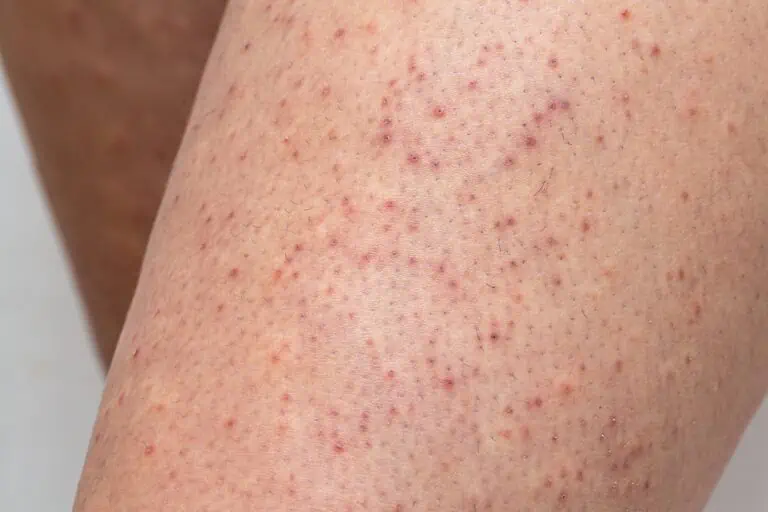Keratosis Pilaris Treatment: How to Get Rid of Chicken Skin

If clusters of small red or white bumps are making your skin look like freshly plucked poultry flesh and feel like sandpaper, you’re probably wondering how to get rid of keratosis pilaris, aka chicken skin. Chicken skin on the arms can banish short-sleeved shirts and sleeveless tops to the back of the drawer, and bumps on the butt cheeks or face can be even more embarrassing. In most cases, keratosis pilaris treatment is simple.
“The condition is harmless and may eventually resolve on its own,” said Stephanie McNamara, MD, a dermatologist at Riverchase Dermatology. “But if it bothers you, you can reduce the symptoms at home with regular use of an exfoliating product and a good moisturizer.” In extreme cases, she added, if keratosis pilaris self-care measures don’t work, you may want to see a dermatologist for prescription topical medication or perhaps laser treatment.
What is keratosis pilaris?
Chicken skin is caused by blocked hair follicles, which is why it shows up only in places that have hair—typically the backs of the arms, the front of the thighs, the cheeks and the buttocks. Clogging the follicles are dead skin cells and keratin, a protein found in skin, hair and nails. On fair skin, the bumps may be whitish, skin-colored, red or pinkish purple. On dark skin they may be brownish black.
It’s not clear what causes keratosis pilaris, though genes play a role. It tends to show up in childhood and often flares at puberty. Between 50 percent and 80 percent of teens have keratosis pilaris, and approximately 40 percent of adults develop it. It’s slightly more common in females and more common in people with close family members who have it.
Certain medical conditions and treatments may increase the risk of keratosis pilaris, including:
- Asthma
- Hay fever
- Overweight or obesity
- Eczema
- Ichthyosis vulgaris (a condition in which skin becomes flaky)
If you’re prone to keratosis pilaris, certain circumstances can make it worse.
“The bumps often appear in cold weather, when skin is especially dry,” said Dr. McNamara. “Lack of hydration can exacerbate keratosis pilaris, and some people find that stress can also cause it to flare up.”
Keratosis pilaris treatment
To treat keratosis pilaris, first see your dermatologist, who can confirm that the bumps aren’t caused by something else—say, acne or a rash.
Next, “Start with a simple two-step approach,” said Dr. McNamara. “Apply an acid-based, over-the-counter topical exfoliating product to loosen and slough off dead skin cells.” Ingredients to look for include:
- Lactic acid
- Salicylic acid
- Glycolic acid
- Urea
Skip the body scrubs for keratosis pilaris that offer physical exfoliation. They may be too harsh for the skin.
“Then, follow up with a moisturizing cream to lock in moisture and prevent skin from becoming dry and flaky,” said Dr. McNamara. If the bumpy skin itches, try using an over-the-counter corticosteroid cream, but follow the directions on the package, and don’t use it more often than recommended.
Tempted to use an exfoliating sponge, loofah, gloves or brush? Don’t. “It really is never beneficial to use abrasive apparatus on the skin, unless it’s the soles of the feet for callus removal,” said Dr. McNamara.
Keratosis pilaris creams and lotions
A variety of creams and lotions are designed to treat rough, bumpy skin via chemical exfoliation. When it comes to the best cream for keratosis pilaris, here are some of Dr. McNamara’s top picks.
AmLactin KP Bumps Be Gone
This body cream combines 15% lactic acid plus a moisturizer to exfoliate and hydrate the skin.
CeraVe SA Cream for Rough & Bumpy Skin
A salicylic acid cream, this also contains lactic acid, hyaluronic acid and niacinamide (vitamin 3). Ceramides lock in hydration for all-day moisture.
Eucerin Roughness Relief Lotion
If you find creams to be too thick, consider this fast-absorbing lotion, which contains urea for exfoliation and shea butter for moisturizing.
Touch KP Exfoliating Lotion
Some people swear by this lotion, which contains 12% glycolic acid and 2% salicylic acid and reduces redness as well as minimizing bumps. Because of the high glycolic acid concentration, you may experience a burning sensation when first using the lotion.
Professional treatment for keratosis pilaris
If your keratosis pilaris is stubborn or severe, your dermatologist may recommend a prescription topical product. Laser therapy is another option if the practice is equipped with the right lasers.
One effective laser treatment is IPL (intense pulsed light), which uses high-intensity pulses of light to smooth the skin and lighten dark spots. A CO2 fractional laser is another option for smoothing the skin and also improving the look of wrinkles and dark spots. Some skincare practitioners recommend microdermabrasion to enhance the effects of laser resurfacing treatments.
Treating keratosis pilaris may take some trial and error. Start with over-the-counter skin care products, experiment to see what works best, and give them time to work—they aren’t instant cures. Don’t skip the moisturizer, which is essential. If you’re not satisfied with the results of keratosis pilaris self-care after you’ve tried several products, see your dermatologist for help.
Medically reviewed by Stephanie McNamara, MD
Written by Maura Rhodes, a writer and editor specializing in health and well-being.


